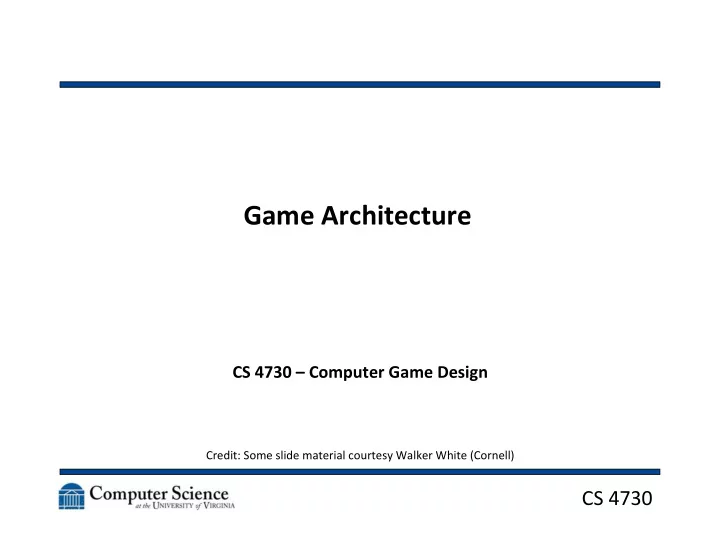

Game ¡Architecture ¡ CS ¡4730 ¡– ¡Computer ¡Game ¡Design ¡ ¡ ¡ ¡ Credit: ¡Some ¡slide ¡material ¡courtesy ¡Walker ¡White ¡(Cornell) ¡ CS ¡4730 ¡
Event-‑Driven ¡Programming ¡ • Consider ¡all ¡the ¡programs ¡you’ve ¡wriFen ¡up ¡to ¡ this ¡point ¡ • Did ¡they ¡do ¡anything ¡when ¡the ¡user ¡didn’t ¡ask ¡ for ¡something? ¡ • Was ¡there ¡processing ¡in ¡the ¡background? ¡ • Or ¡did ¡it ¡mainly ¡respond ¡to ¡user ¡input? ¡ CS ¡4730 ¡ 2
Event-‑Driven ¡Programming ¡ • The ¡event-‑driven ¡paradigm ¡works ¡great ¡for ¡a ¡ lot ¡of ¡systems ¡ – Web ¡(we ¡REALLY ¡want ¡this!) ¡ – Mobile ¡ – Office ¡apps ¡ • But ¡is ¡this ¡what ¡we ¡want ¡in ¡this ¡class? ¡ • Well… ¡maybe ¡if ¡we ¡were ¡only ¡programming ¡ board ¡games… ¡ CS ¡4730 ¡ 3
Event-‑Driven ¡Gaming ¡ • Consider ¡board ¡games ¡ • They ¡are, ¡in ¡fact, ¡event-‑driven ¡in ¡many ¡cases ¡ • There ¡are ¡some ¡things ¡that ¡happen ¡“behind ¡the ¡ scenes” ¡ – Upda[ng ¡tallies ¡ – Shuffling ¡the ¡deck ¡ – Deciding ¡the ¡moves ¡of ¡the ¡“bad ¡guys” ¡ • But ¡not ¡all ¡games ¡are ¡like ¡this ¡ CS ¡4730 ¡ 4
The ¡Game ¡Loop ¡ ¡ ¡ ¡ ¡ ¡ ¡ ¡ ¡ ¡ Credit: ¡Walker ¡White ¡ CS ¡4730 ¡ 5
Step ¡1. ¡Player ¡Input ¡ • Remember: ¡player ¡input ¡is ¡one ¡set ¡of ¡variables ¡ that ¡enter ¡our ¡equa[on ¡to ¡affect ¡game ¡state ¡ • Input ¡is ¡typically ¡polled ¡during ¡game ¡loop ¡ – What ¡is ¡the ¡state ¡of ¡the ¡controller? ¡ – If ¡no ¡change, ¡do ¡no ¡ac[ons ¡ • However, ¡we ¡can ¡only ¡read ¡input ¡once ¡per ¡ game ¡loop ¡cycle ¡ • But ¡good ¡frame ¡rate ¡is ¡short ¡and ¡most ¡events ¡ are ¡longer ¡than ¡one ¡frame ¡ CS ¡4730 ¡ 6
Step ¡2. ¡Process ¡ac[ons ¡ • Alter ¡the ¡game ¡state ¡based ¡on ¡your ¡input ¡ • We’ve ¡discussed ¡this! ¡ • These ¡are ¡the ¡player ¡ac[ons ¡/ ¡verbs ¡ • However, ¡don’t ¡lock ¡the ¡controller ¡to ¡directly ¡ changing ¡the ¡state! ¡ • Place ¡a ¡buffer ¡here ¡– ¡have ¡it ¡call ¡a ¡method ¡ which ¡allows ¡some ¡flexibility ¡in ¡design ¡later ¡ CS ¡4730 ¡ 7
Step ¡3. ¡Process ¡NPCs ¡ • An ¡NPC ¡(Non-‑Player ¡Character) ¡is ¡anything ¡that ¡has ¡ voli[on ¡in ¡the ¡world ¡that ¡isn’t ¡you ¡ • NPCs ¡take ¡input ¡from ¡the ¡AI ¡engine ¡(maybe!) ¡but ¡not ¡ from ¡a ¡direct ¡controller ¡ • Work ¡on ¡the ¡idea ¡of ¡Sense-‑Think-‑Act: ¡ – Sense ¡the ¡state ¡of ¡the ¡world ¡around ¡it ¡(how ¡can ¡we ¡ “cheat” ¡here ¡to ¡make ¡an ¡NPC ¡“harder”?) ¡ – Think ¡about ¡what ¡ac[on ¡to ¡perform ¡(usually ¡limited ¡ choices) ¡ – Act ¡in ¡the ¡world ¡ CS ¡4730 ¡ 8
Step ¡3. ¡Process ¡NPCs ¡ • Problem ¡is ¡sensing ¡is ¡hard! ¡ – What ¡does ¡the ¡NPC ¡need ¡to ¡know? ¡ – What ¡is ¡the ¡state ¡of ¡ALL ¡OTHER ¡OBJECTS? ¡ ¡UGH. ¡ • Limit ¡sensing? ¡ ¡“Cheat?” ¡ • Another ¡problem ¡– ¡thinking ¡is ¡hard! ¡ – Can ¡take ¡more ¡than ¡one ¡frame ¡to ¡decide ¡what ¡to ¡do! ¡ – Act ¡without ¡thinking? ¡ – What ¡if ¡one ¡acts, ¡then ¡the ¡next ¡acts ¡on ¡that ¡ac[on? ¡ • More ¡in ¡AI ¡and ¡Pathfinding! ¡ CS ¡4730 ¡ 9
Step ¡4. ¡World ¡Processing ¡ • Physics! ¡ • Ligh[ng! ¡ • Collisions! ¡ • So ¡much ¡cool ¡stuff! ¡ • But ¡later! ¡ J ¡ CS ¡4730 ¡ 10
Drawing ¡ • Well, ¡it ¡needs ¡to ¡be ¡fast! ¡ – We ¡want ¡to ¡do ¡as ¡liFle ¡computa[on ¡as ¡possible ¡ – Draw ¡ONLY ¡what’s ¡on ¡the ¡screen! ¡ • Keep ¡the ¡drawing ¡and ¡the ¡state ¡modifica[on ¡ separate! ¡ • PreFy ¡easy ¡to ¡do ¡in ¡MonoGame ¡ CS ¡4730 ¡ 11
Architecture ¡Big ¡Picture ¡ ¡ ¡ Credit: ¡Walker ¡White ¡ CS ¡4730 ¡ 12
Recommend
More recommend